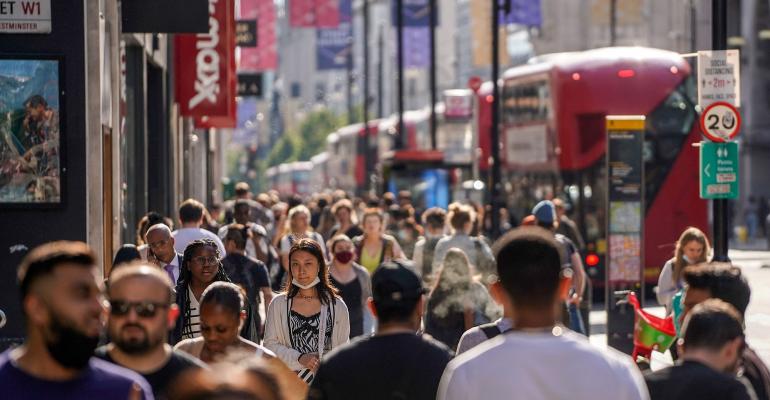(Bloomberg) -- So long social distancing, goodbye working from home. That was the plan, anyway. Yet while almost all restrictions imposed to curb the spread of coronavirus have now been lifted in England, sharply rising levels of Covid-19 mean the country is nowhere near returning to “normal.”
“Freedom Day” — as part of the British press have dubbed today — is no end-of-pandemic celebration. Many major employers will go on limiting the number of workers who can enter their offices. Others, like Goldman Sachs Group Inc. and JPMorgan Chase & Co. will continue making masks mandatory in their buildings even though the government has relaxed the rules. If you return to the office now, it will look very different to the one you left 16 months ago.
With cases and hospitalizations rising, the return to normality is likely to be slow and faltering. But if you do venture into central London, here are five things to watch for:
You Risk Being Told to Self-Isolate
There’s one key reason why London-based workers are expected to remain reticent about heading into the city over the next month: the risk either of contracting Covid-19 or coming into close contact with an infected person.
Daily positive test numbers in the U.K. passed 54,000 on Saturday and 47,000 on Sunday. That’s more than Indonesia, the pandemic’s current epicenter, according to data compiled by Johns Hopkins University. The Office for National Statistics estimated on Friday that 1 in 95 people in England has the virus.
Read More: U.K. Set for Big Reopening as Cases Soar the Most in the World
Those numbers explain why a record 520,194 people in England were “pinged” by the National Health Service Covid-19 app and advised to self-isolate in the week ending July 7. More people are expected to be notified as cases rise. Self-isolation for fully vaccinated people will not be ended until Aug. 16, with businesses, retail , hospitals and even transport networks struggling with staff absences as a result.
Offices Aren’t Filling Up
Offices themselves, the reasons so many millions of people leave their homes and travel into cities each week, remain some 30% less busy than they were before March 2020.
Data from Google Inc.’s wide-ranging Community Mobility Reports, which aggregate location data for a host of global cities, show that while London recovered somewhat by late 2020 after the initial pandemic slump, the winter lockdown reversed all those gains. Workplace activity has increased in recent weeks, but the city is far from operating “normally.”
The Tube Is Still Unpopular
Crowded spaces with poor ventilation are almost tailor-made for spreading Covid-19. Despite London’s transport authorities’ best attempts to reassure travelers, busy Underground services around peak-time travel are impossible to make entirely safe.
Travelers seem to agree, with experimental journey data from Transport for London showing that almost half the number of Tube journeys were taken in early July compared to the weeks before the pandemic began.
Lunchtime Isn’t What It Used to Be
Shops, cafes, restaurants and pubs were allowed to reopen in stages over the spring, and most are counting on commuters to return to their offices for their survival. But it’s been a slow process.
Bloomberg is tracking the recovery using data from London-based global sandwich chain Pret A Manger Ltd. Our weekly Pret Tracker shows a solid recovery in London’s West End and suburbs — but in the City and Canary Wharf, home to a number of large banks, trade has plateaued after breaching the 50% barrier.
But You Might Be Able to Get a Table
Indoor dining reopened in May across England, and outdoor dining has been legal since the chilly days of spring. But data from restaurant booking provider OpenTable Inc. shows that reservations in the capital are picking up more slowly than in the rest of the U.K.
While bookings in the country as a whole have recovered strongly as diners regain their interest in eating out, London destinations remain on the wrong side of OpenTable’s 2019 baseline.
--With assistance from Damian Shepherd and Jeremy Diamond.
To contact the author of this story:
Adam Blenford in London at [email protected]
© 2021 Bloomberg L.P.





